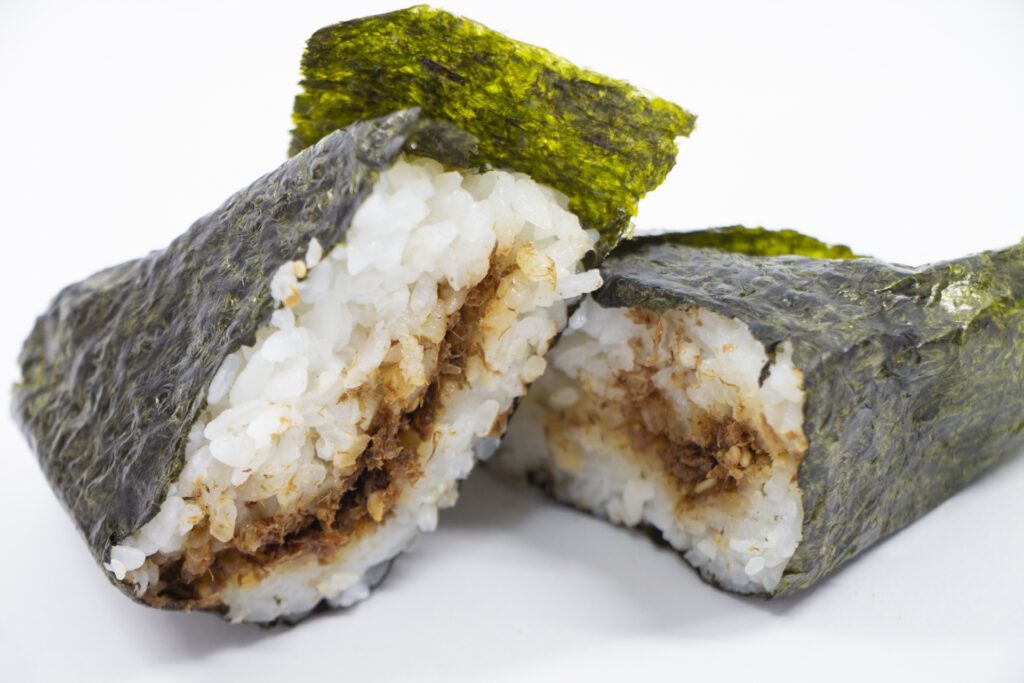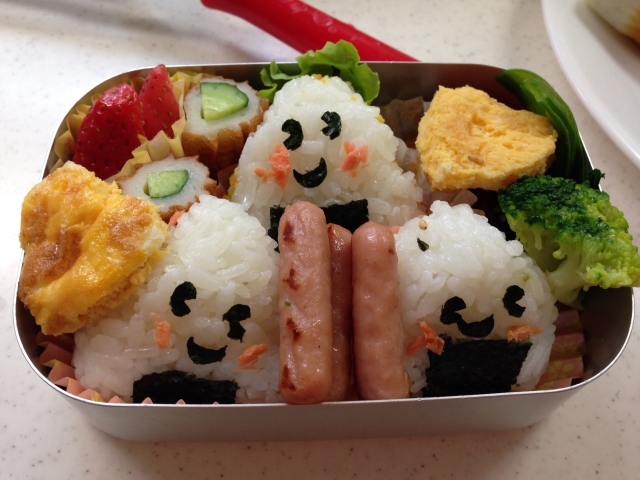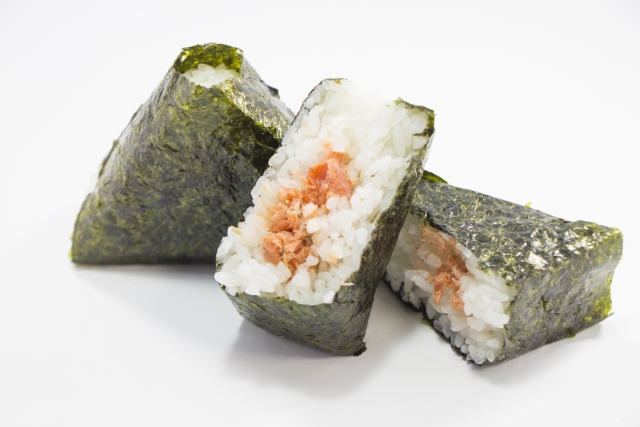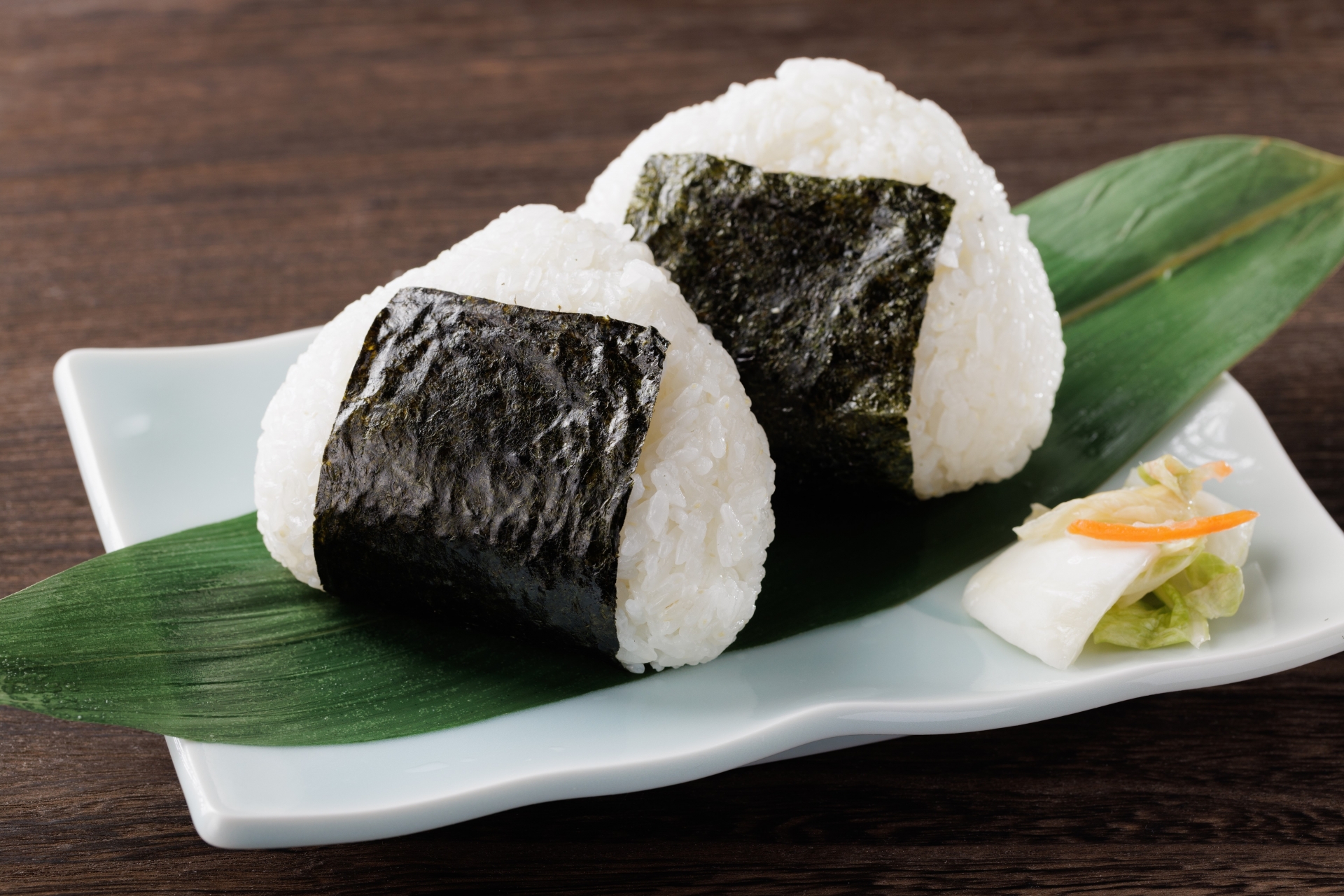Konnichiwa! In this post we will cover everything to know about the magical Japanese rice triangles, better known as onigiri!
Affiliate Disclaimer: I only recommend products I would use myself and all opinions expressed here are our own. This post may contain affiliate links that at no additional cost to you, I may earn a small commission. As an Amazon Associate I earn from qualifying purchases.
What is Onigiri?
Ah, onigiri! These cute, compact rice triangles are a beloved staple in Japan and a popular snack enjoyed by people of all ages. Onigiri is essentially a handheld rice ball, made by shaping cooked rice into a triangular or cylindrical form and often filled with delicious ingredients.
In Japan, onigiri is an essential part of bento boxes, picnics, school lunches, and a quick on-the-go snack. It’s the ultimate comfort food that feels like a warm hug from grandma. The best part? Onigiri is incredibly customizable, so you can mix and match your favorite fillings to create your perfect rice triangle!
How to Make Onigiri
Making onigiri is a breeze, and it’s a fun activity to do with friends and family. Here’s a step-by-step guide to crafting your own rice triangles:
Step 1: Cook the Rice
The key to perfect onigiri lies in the rice. Use short-grain Japanese rice for that ideal sticky texture. Cook the rice as usual, following the package instructions or using a rice cooker for consistent results. Check out my rice cooker recommendations here.
Step 2: Season the Rice
Once the rice is cooked and still warm, season it with a mixture of rice vinegar, salt, and a pinch of sugar. This adds a hint of tanginess and enhances the overall flavor of the onigiri.
Step 3: Prepare Your Fillings
The beauty of onigiri is in the fillings! Traditional options include umeboshi (pickled plum), salmon, tuna, and bonito flakes. Get creative and try ingredients like grilled chicken, tempura shrimp, or even sautéed vegetables. The choices are endless!

Step 4: Shape the Onigiri
Moisten your hands with a bit of water to prevent the rice from sticking. Take a handful of rice and press it gently into your desired shape – triangular or cylindrical. Make a little well in the center and add your filling. If you prefer, you can use a mold to make the shape more “perfect”.
Step 5: Close and Wrap
Carefully fold the rice over the filling, ensuring it’s well enclosed. If you’re feeling fancy, you can wrap your onigiri with a strip of nori (seaweed) to add extra flavor and make it easier to hold.

What Type of Rice Do You Use for Onigiri?
Feel free to use any rice you want for onigiri. For that perfect onigiri texture, though, opt for uruchimai, commonly known as Japonica rice. This variety has a higher starch content, giving the rice its signature stickiness and making it easier to shape into those cute triangles. While you can experiment with other rice types, short-grain rice is the way to go for the ultimate onigiri experience. Learn more about different types of Japanese rice in my other blog post.
What are Good Fillings for Onigiri?
The filling possibilities for onigiri are as vast as your imagination! Traditional fillings include:

But don’t stop there! Try adding your favorite proteins, veggies, or even scrambled eggs. The beauty of onigiri is that there’s no right or wrong filling – it’s all about what makes your taste buds dance!
How is Onigiri Different from Sushi?
Onigiri and sushi are like distant cousins – they both involve rice, but they have some key differences:
What is the Difference Between Rice Balls and Onigiri?
Rice balls and onigiri are often used interchangeably, but there are subtle differences in their preparation and context:

Planning a trip to Japan?
Summing It Up
In conclusion, onigiri is the epitome of comfort food that brings joy with every bite. It’s a versatile and customizable snack that caters to your cravings and allows you to get creative with fillings. Whether you’re enjoying it as a quick bite on the go or savoring it in a relaxing picnic, onigiri is sure to steal your heart.
FAQs – All About Onigiri
Q1. Can I make onigiri with any type of rice?
While short-grain Japanese rice is the traditional choice for onigiri, you can experiment with other rice types if you prefer. Keep in mind that the stickiness of short-grain rice helps in shaping the rice triangles.
Q2. How long can I store onigiri?
Onigiri is best enjoyed fresh but can be stored for a few hours at room temperature. If you plan to keep them longer, store them in an airtight container in the refrigerator for up to a day.
Q3. Are there vegetarian or vegan fillings for onigiri?
Absolutely! Onigiri can be made with an array of vegetarian and vegan fillings like pickled vegetables, seasoned tofu, grilled eggplant, or sautéed mushrooms. Get creative and explore plant-based options that suit your taste.
Q4. Can I freeze onigiri?
Yes, you can freeze onigiri! Wrap them tightly in plastic wrap or place them in an airtight container before freezing. To enjoy, let them thaw in the refrigerator or at room temperature, then reheat if desired.
Q5. Can I find onigiri in restaurants or stores outside Japan?
While onigiri is more commonly found in Japan, its popularity has spread beyond its borders. In recent years, onigiri has gained recognition as a delicious and convenient snack, leading to its availability in various Japanese restaurants, specialty food stores, and even some mainstream grocery stores in different countries, including the United States.
Japanese restaurants and izakayas often include onigiri on their menus, offering a delightful range of fillings for customers to enjoy. You might find traditional fillings like umeboshi, grilled salmon, and tuna mayo, as well as creative twists with modern ingredients to suit diverse tastes.
Additionally, some specialty Asian grocery stores or Japanese markets stock pre-packaged onigiri, making it even more accessible for those seeking a quick and satisfying snack. These pre-made options often come in a variety of flavors, allowing you to try different fillings without the need for preparation.
For those who love a culinary adventure, making your own onigiri at home can be a rewarding experience. You can purchase short-grain Japanese rice from these same specialty stores or find it in the international section of many supermarkets. Investing in a pack of nori seaweed and a few of your favorite fillings opens the door to endless possibilities in the world of onigiri crafting.
So, whether you’re venturing out to discover the delightful world of onigiri at a local restaurant or enjoying the creative process of making your own rice triangles at home, onigiri is sure to become a beloved addition to your snack repertoire.
Q6. Can I eat onigiri at room temperature or do I need to heat it up?
Onigiri is traditionally enjoyed at room temperature, making it a convenient and portable snack. While it can be eaten straight from the fridge, some people prefer to let it sit at room temperature for a few minutes to enhance the flavor.
Q7. Is onigiri gluten-free?
Yes, onigiri can be gluten-free, depending on the fillings you choose. Many traditional fillings like umeboshi, pickled vegetables, and plain grilled proteins are gluten-free. However, be cautious of certain fillings or sauces that may contain gluten.
Q8. Can I serve onigiri as part of a meal or only as a snack?
Onigiri is highly versatile and can be served as both a snack and as part of a meal. In Japan, it’s often included in bento boxes for lunch or enjoyed as a quick bite during picnics or while traveling.
Q9. Are there regional variations of onigiri in Japan?
Yes, regional variations of onigiri exist in Japan, with different fillings and seasonings reflecting local tastes and ingredients. For example, in Okinawa, onigiri is sometimes made with purple sweet potatoes.
Q10. Can I make onigiri in advance for meal prepping?
Absolutely! Onigiri is a great option for meal prepping. Make a batch in advance, wrap them in plastic wrap or store them in an airtight container, and refrigerate or freeze them. This way, you can enjoy them throughout the week without the need for daily preparation.

